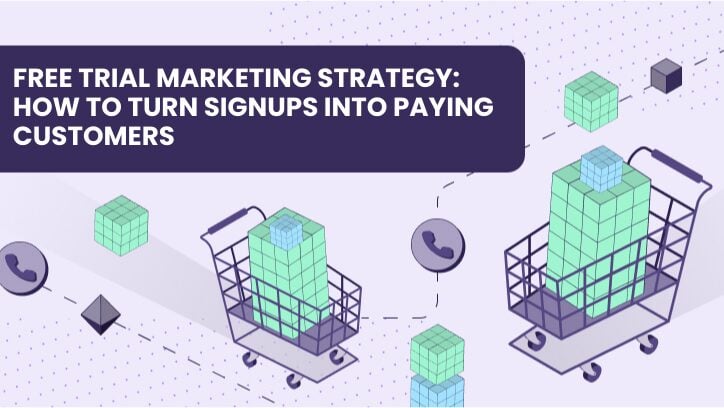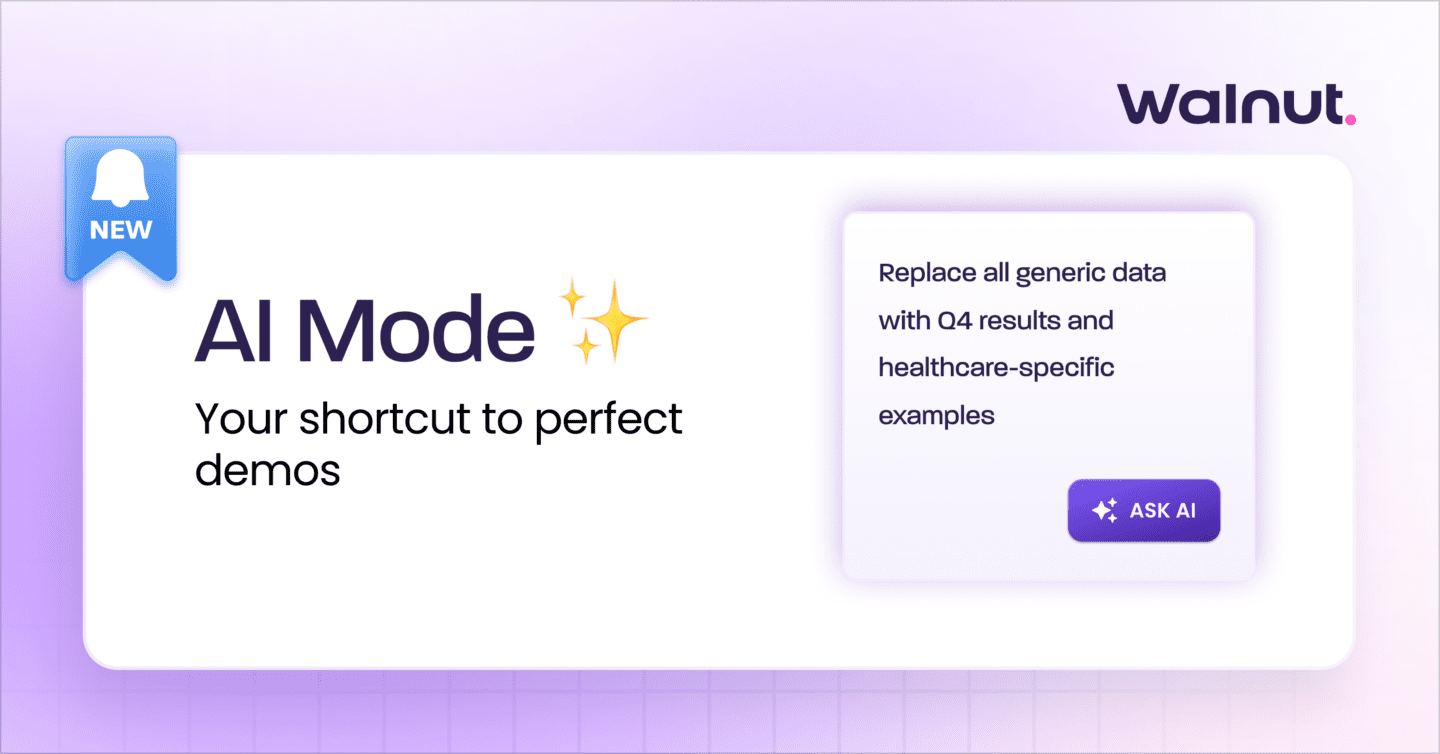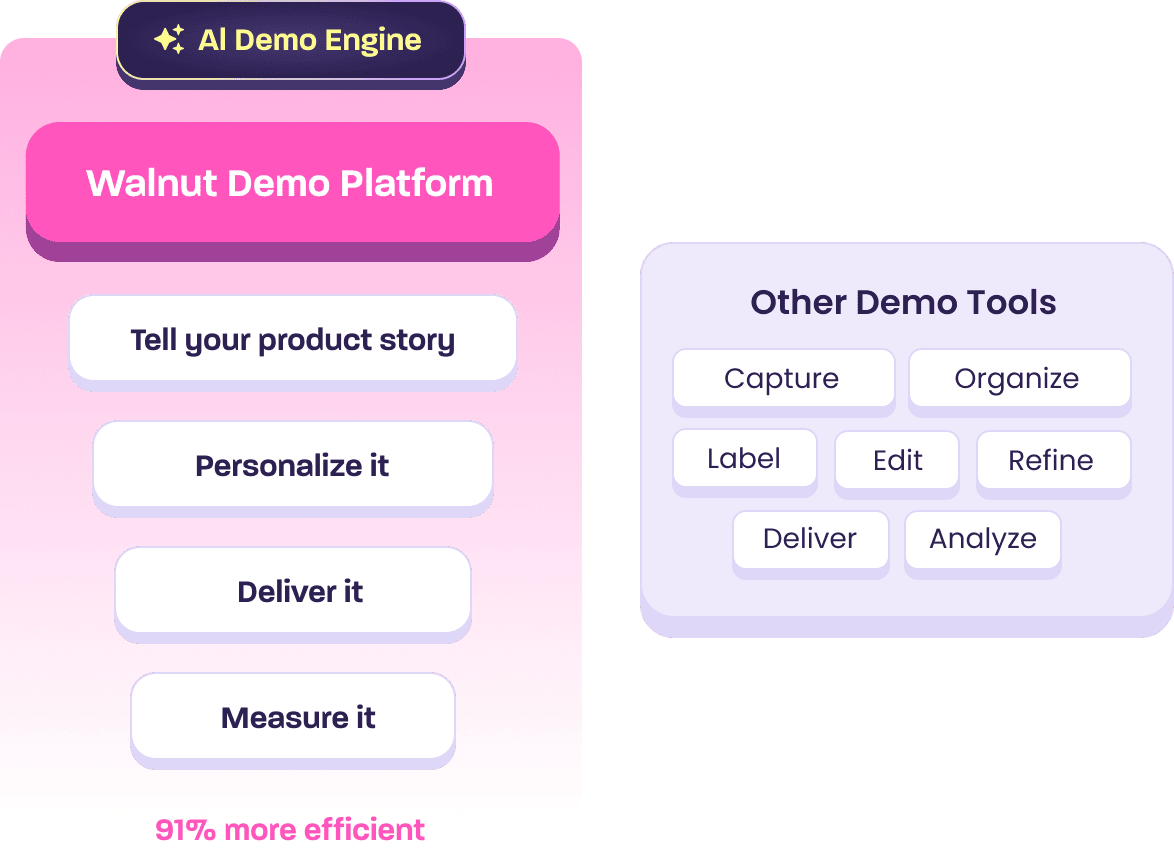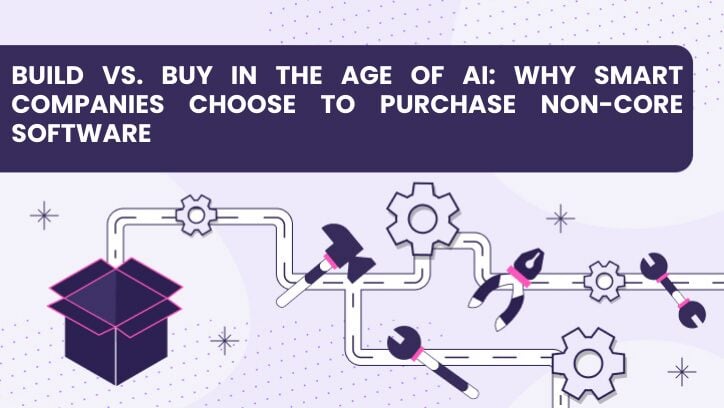Attracting signups isn’t the finish line. It’s the starting gun. The real job is guiding people from “I’m interested” to “I see the value” before their attention moves on. A high-performing free trial marketing strategy does exactly that. It removes friction, spotlights value fast, and gives buyers the confidence to say yes.
We’ve pulled together a practical playbook for SaaS teams. It blends proven lifecycle tactics with the modern motion we see winning today. And of course, we’ve added in how you can use interactive demos and interactive deal rooms to power the journey from first touch to paid conversion.
Practical checklist
- Choose trial model and set one activation moment
- Build a 2–3 minute interactive demo that mirrors the “day in the life” outcome
- Create first-session guidance and sample data for instant value
- Launch a behavior-based email sequence tied to activation and pricing intent
- Package an interactive deal room for late-trial decision making
- A/B test first-session guide, sample data, and demo path before anything else
Why free trials win
Buyers want to self-serve, see value fast, and loop in stakeholders only when it matters. A modern free trial marketing strategy meets them there. It reduces perceived risk, proves outcomes in minutes, and captures intent with data you can act on. The result: shorter cycles, higher trust, and more revenue.
Walnut perspective:
- Trials fix the “blank product” problem that frustrates prospects. The “blank product” problem is when potential customers struggle to visualize the value or functionality of a product without direct interaction. They might see a list of impressive features, glowing testimonials, or detailed demonstrations, but until they can actually use the product themselves, a degree of skepticism or uncertainty often remains.
- Increased trust leads to increase trial-to-paid conversion: Getting prospects to convert to paying customers is the ultimate goal of a free trial. The stronger the correlation between activation and time-to-value (TTV), the higher this conversion rate will be.
When users activate quickly and experience value early, they build momentum and see the product as a viable solution, making the transition to a paying customer a natural next step. Conversely, low activation rates and long TTVs often lead to high churn during the trial period.
A successful free trial strategy puts getting users to experience the core value of the product, as quickly and effortlessly as possible, first. This front-loads the benefits, builds confidence in the solution, and significantly increases the probability of converting trial users into long-term, paying customers.
- Interactive demos plus trial analytics give the evidence to invest.
Integrating interactive product demos with robust trial analytics provides concrete evidence to justify further investment in your product or service. When potential customers can actively experience the value and functionality through a demo, and their engagement is meticulously tracked and analyzed during the trial period, businesses gain invaluable insights.
This approach allows you to identify what features resonate most, where users encounter friction, and ultimately, which trial participants are most likely to convert into paying customers.
The combo of these two powerful tools validates your product’s potential and highlights areas for improvement, ensuring that future development efforts are strategically aligned with user needs and business growth.
The Free Trial Marketing Strategy Playbook
- Pick the right trial model and duration
When deciding on the length of your free trial, consider the complexity of your product or service. For simple offerings, a shorter trial period may be sufficient for users to understand its value. However, for more intricate solutions, a longer trial duration allows customers to fully explore and appreciate the benefits.
Another factor to consider is customer behavior. Studies have shown that a 14-day free trial is often the most effective in converting signups into paying customers. This timeframe gives users an adequate amount of time to test out your offering and make an informed decision about its worth.
In addition, be mindful of industry standards and competitors’ practices when determining your free trial duration. Analyzing what has worked well for similar products can provide valuable insights into what resonates with potential customers and increases conversion rates.
Match time to complexity.
- Shorter trials (7–14 days) work for focused products with fast time-to-value.
- Longer trials (21–30 days) fit complex workflows, integrations, or multiple personas.
If your buyer needs approvals or data imports, plan for that.
When planning for your buyer’s journey, it’s crucial to anticipate potential roadblocks that might require approvals or data imports. These often involve internal processes within the buyer’s organization that can slow down or halt the adoption of your product or service.
Here’s a list of approvals that might be helpful to bake into your planning process. With Walnut’s IDR
Here’s a list of approvals that might be helpful to bake into your planning process when designing a free trial marketing strategy. With Walnut’s Interactive Demo experience (IDR), you can streamline your sales process and gain valuable insights into user engagement, which in turn can help you secure the necessary approvals for your free trial initiatives. These approvals often involve various stakeholders across different departments to ensure alignment and mitigate potential risks.
Approvals:
- Financial Approvals: If your offering has a significant cost, it will likely require budget approval from a finance department or executive. This often involves multiple layers of sign-off.
- Legal Approvals: Depending on the nature of your product (especially in regulated industries), legal teams may need to review contracts, terms of service, or compliance aspects.
- Security Approvals: For software or cloud-based solutions, security teams will often need to assess data privacy, system vulnerabilities, and access controls.
- IT Approvals: New software or hardware implementations frequently require IT department approval for compatibility, integration, and resource allocation.
- Stakeholder Approvals: Beyond formal departmental approvals, key stakeholders (managers, team leads, end-users) may need to give their informal or formal “okay” for a successful rollout and adoption.
Data Imports:
- Data Migration: If your solution replaces an existing system, the buyer will need to migrate their historical data. This can be a complex process involving data cleaning, mapping, and transfer.
- Integration with Existing Systems: Your product may need to integrate with other tools the buyer already uses (e.g., CRM, ERP, marketing automation platforms). This requires understanding their current tech stack and planning for API connections or custom integrations.
- Data Formatting and Quality: Data often exists in various formats and may have inconsistencies. Planning for data formatting, cleansing, and ensuring data quality is essential before import.
- Security and Privacy of Data: When handling customer data, especially sensitive information, ensure compliance with data privacy regulations (e.g., GDPR, CCPA) and establish secure data transfer protocols.
Strategies to Address These:
- Proactive Identification: During the sales process, actively inquire about their internal approval processes and existing systems. Use discovery questions to uncover potential hurdles.
- Provide Necessary Documentation: Prepare all required documentation in advance, such as security whitepapers, compliance certifications, technical specifications, and legal templates.
- Facilitate Internal Communication: Offer to provide materials or presentations that help your buyer advocate for your solution internally.
- Dedicated Onboarding/Implementation Support: Have a clear plan and dedicated resources for onboarding and implementation, including technical assistance for data imports and integrations.
- Pilot Programs: Consider offering a pilot program or a phased rollout to allow internal teams to test the solution and gather feedback before full-scale adoption.
- Training and Education: Provide comprehensive training for users and administrators to ensure smooth adoption and address any data-related queries.
- Clear Communication of Timelines: Set realistic expectations regarding the time required for approvals and data imports.
Choose a motion:
- Opt-in free trial. Standard 14 days. Lower friction, broader top-of-funnel.
- Reverse trial. Start with premium features, then revert to a free plan unless they upgrade. Great for showing the “real” product experience up front.
- POC-style trial. Structured, milestone based. Use for enterprise deals where security and stakeholder signoff matter.
The Power of the Single Activation Moment
In the world of free trials, success hinges on identifying and optimizing for a “single activation moment.” Instead of overwhelming users with a multitude of features, you pinpoint the one action that most strongly correlates with eventual conversion to a paying customer. Once this action is identified, your entire product experience, onboarding flow, and marketing efforts should be meticulously designed to guide users to achieve this moment as swiftly and seamlessly as possible.
Tip: If your product is hard to grok in 5 minutes, pair the trial with an interactive demo that previews the “day in the life” outcome before users set anything up. It reduces time-to-value and filters unqualified signups.
2) Design the first 5 minutes like a product marketer
Make the “aha” obvious.
Greet users with a short, pre-personalized path. Skip empty states. Skip blank canvases. Use a guided flow that looks like their world.
Give two crisp paths:
- Guided value tour for new users who want to see the outcome.
- Hands-on setup for power users who want to click.
Bring the story to life.
Use interactive demos to showcase outcomes, not features. Let users choose their role or use case, then branch the story. Think “choose your own adventure,” not “feature parade.”
3) Make social channels work for your trial
Lead with outcomes, show receipts.
Short clips or carousels that demonstrate a before/after scenario outperform generic “start a free trial” posts.
Platform plays that convert:
- LinkedIn: Use customer quotes, quick product teardowns, and a CTA that lands on an interactive demo plus trial.
- YouTube/Shorts: Feature a 60–90 second walkthrough of the exact activation moment users will hit in the trial.
- Retargeting: Build audiences from demo viewers and site visitors, then serve them the next best action: book time, enter the trial, or open an interactive deal room that packages everything they need.
Create urgency without gimmicks.
Limited-time onboarding help, priority setup calls, or template packs beat countdown clocks for B2B buyers.
4) Email that actually moves trials forward
Personalize by behavior, not just name.
Trigger emails from actions: started trial, didn’t import data, viewed pricing, watched a specific section of your demo.
A simple, high-converting sequence:
- Welcome + 90-second value tour. Show the outcome. Link to the guided path or interactive demo.
- Activation nudge. Remove the first sticking point with a one-click template or sample data.
- Use-case spotlight. Branch by persona. “If you’re a RevOps leader, here’s the 3-step workflow you’ll love.”
- Proof + social validation. Short case study, one metric, one quote.
- Decision helper. Pricing explainer, ROI snapshot, and a path to talk to sales.
- Last-week reminder. Offer help, not pressure. Invite them into an interactive deal room that packages the demo, ROI one-pager, security docs, and next steps in one place.
5) Calls to action that convert
Keep it clear, specific, and benefit led:
- “See a 2-minute use case, then start your trial”
- “Load sample data and hit your first win”
- “Open your deal room to compare plans and next steps”
Avoid vague asks. Every CTA should tell users exactly what they’ll get and how it advances their goal. Each and every CTA should function as a clear and concise directive, leaving no room for misinterpretation. Users need to immediately understand precisely what they will gain by interacting with the CTA and, more importantly, how that specific action contributes to the accomplishment of their overarching goals. Vague or generic CTAs, such as “Click Here” or “Learn More,” provide insufficient information and often lead to hesitation or confusion, ultimately hindering conversion rates. Instead, focus on actionable language that highlights the immediate benefit and the next logical step in their journey.
6) Measure what matters
Optimize Your Free Trial Strategy: Focus on the Entire Funnel
Track the full funnel, not just trial starts. While a high number of sign-ups is encouraging, it doesn’t paint the full picture of your free trial’s effectiveness. To truly optimize your strategy and convert trial users into paying customers, you need to track the full funnel, not just trial starts.
This means monitoring user behavior and engagement from the moment someone lands on your trial landing page, through the onboarding process, during their active use of the trial, and even after the trial period ends. By understanding the entire user journey, you can identify bottlenecks, optimize conversion points, and ultimately drive more paying customers.
Here’s a breakdown of what “tracking the full funnel” entails:
- Pre-Trial Engagement:
- Website Visits & Landing Page Conversions: How many visitors land on your free trial page? What is the conversion rate from visitor to sign-up? Are there specific marketing channels driving high-quality leads?
- Marketing Channel Effectiveness: Which marketing channels (e.g., organic search, paid ads, social media, referrals) are generating the most qualified trial sign-ups?
- Trial Onboarding & Activation:
- Onboarding Completion Rate: How many users complete your onboarding process? Where do users drop off during onboarding?
- Key Feature Adoption: Are trial users engaging with the core features of your product? What are the “aha!” moments that indicate a user understands the value of your offering?
- Time to Value (TTV): How quickly do users experience the core benefit or solution your product provides? A shorter TTV often correlates with higher conversion rates.
- Engagement Metrics: Track metrics like daily active users (DAU), weekly active users (WAU), session duration, and feature usage to gauge how actively users are exploring your product during the trial.
- In-Trial Engagement & Support:
- User Support Interactions: Are trial users reaching out for help? What are their common questions or pain points? This can highlight areas where your product or onboarding needs improvement.
- In-App Messaging & Guidance: Are your in-app messages and tutorials effectively guiding users toward deeper engagement and understanding?
- Feature Churn: Are users starting to use certain features and then abandoning them? This could indicate usability issues or a lack of perceived value.
- Trial Conversion & Retention:
- Trial-to-Paid Conversion Rate: This is the ultimate metric for your free trial’s success. What percentage of trial users convert into paying customers?
- Customer Lifetime Value (CLTV): Beyond initial conversion, are your trial-acquired customers becoming valuable, long-term customers?
- Churn Rate: How many of your trial-acquired customers churn after a certain period? Understanding churn can help you identify post-conversion issues.
- Feedback & Surveys: Gather feedback from both converting and non-converting trial users to understand their motivations and reasons for staying or leaving.
By meticulously tracking these metrics across the entire funnel, you can:
- Identify Conversion Bottlenecks: Pinpoint exactly where users are dropping off and address those issues.
- Optimize Onboarding: Refine your onboarding process to ensure users quickly grasp your product’s value.
- Improve Product Features: Understand which features resonate with trial users and which need refinement.
- Personalize User Experiences: Segment users based on their in-trial behavior and tailor your communication and offers accordingly.
- Forecast Revenue More Accurately: A complete funnel view provides a more realistic understanding of your potential revenue from free trials.
- Drive Strategic Decisions: Data from the full funnel empowers you to make informed decisions about marketing spend, product development, and customer support.
Ultimately, a successful free trial strategy goes far beyond simply attracting sign-ups. It requires a holistic approach to tracking and optimizing the entire user journey, transforming curious trial users into satisfied, long-term paying customers.
Core metrics
- Visitor → trial start rate
- Activation rate (users who reach the “aha” action)
- Time-to-value (time to activation)
- PQL → opportunity conversion
- Trial → paid conversion
- Feature engagement by persona
- Content assists (which demo sections and assets show up in won deals)
Run A/Bs on the few things that move mountains: first-session guide, sample data, interactive demo path, and pricing clarity in the final 3 days.
7) Enterprise readiness without the slow-down
Trials stall in bigger orgs for predictable reasons. Clear the path.
- Security upfront. Publish SOC 2, DPA, and data handling in an easy-to-share package.
- Roles and permissions. Let teams invite stakeholders safely during the trial.
- Integration previews. Show how you integrate with Salesforce, HubSpot, and identity providers inside an interactive demo, then let admins verify in a sandbox.
For larger organizations, free trials often falter due to a few common and predictable obstacles. By proactively addressing these, you can significantly improve conversion rates:
- Security Upfront: Enterprise-level clients prioritize data security and compliance. To alleviate concerns and streamline the approval process, make all relevant security documentation readily available. This includes:
- SOC 2 Report: Provide easy access to your latest Service Organization Control (SOC) 2 report, demonstrating your commitment to data security.
- Data Processing Addendum (DPA): Clearly outline your data processing practices and responsibilities in a DPA that’s simple to review and share.
- Data Handling Policies: Publish comprehensive documentation on your data handling procedures, including encryption, access controls, and incident response plans.
- Easy-to-Share Package: Bundle these documents into a single, easily downloadable or shareable package that can be distributed to internal security and legal teams.
- Roles and Permissions: In larger organizations, trials involve multiple stakeholders with varying access needs. Enable teams to invite colleagues and supervisors safely and efficiently during the trial period. This means offering:
- Granular Role-Based Access Control (RBAC): Allow administrators to define specific roles with tailored permissions, ensuring users only have access to the functionalities relevant to their responsibilities.
- Secure Invitation Mechanisms: Implement robust invitation processes that ensure only authorized individuals can join the trial.
- Clear Permission Management: Provide an intuitive interface for managing user roles and permissions, making it easy for trial administrators to add or remove team members and adjust their access levels.
- Integration Previews: Many enterprise software solutions need to integrate seamlessly with existing technology stacks. Demonstrate these crucial integrations effectively to show immediate value. Consider:
- Interactive Demos: Provide interactive product tours or simulations that showcase how your solution integrates with popular platforms like Salesforce, HubSpot, and various identity providers (e.g., Okta, Azure AD). These demos should highlight key workflows and data synchronization.
- Sandbox Environments for Verification: Offer a secure sandbox environment where IT administrators or technical teams can independently verify the integration capabilities. This allows them to test data flows, authentication, and other critical functionalities without impacting their production systems.
- Comprehensive Integration Documentation: Supplement the demos and sandboxes with detailed documentation on API endpoints, data models, and configuration guides for each integration.
Where Walnut fits in your free-trial strategy
If your trial is the “hands-on,” Walnut is the “value-on.”
- Pre-trial demand: Embed interactive demos on your site and in campaigns so buyers see outcomes before they ever sign up. That creates more qualified trials.
- In-trial guidance: Use demo playlists to show role-based paths and advanced use cases without making users configure everything first.
- Champion enablement: Spin up an interactive deal room to bundle demos, security docs, ROI one-pagers, and mutual next steps so your champion can drive internal consensus.
- Demo analytics: See which chapters buyers watch and what they skip, then tune your onboarding and sales follow-up around what actually lands.
Ready to put this into practice with interactive demos and deal rooms that accelerate your trial conversions? Build your first interactive demo





